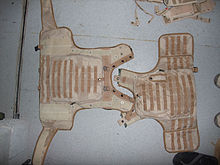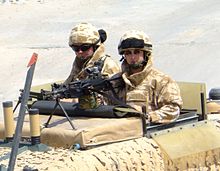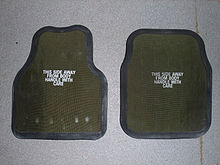- Osprey body armour
-
Osprey body armour is a system of body armour used by the British Armed Forces. The system is in its fourth iteration following extensive development and engagement with front line users.
Contents
Heritage
British armed forces have used Combat Body Armour, and then Enhanced Combat Body Armour during Operation Banner, combating terrorist activities in Northern Ireland. ECBA was issued to ground force elements during the early stages of Operation Telic, the invasion of Iraq in 2003.
Following lessons identified in Iraq by both British and American forces the Osprey armour system was released in 2006 for general use. It has subsequently been developed and in late 2010 Version 4 has been issued to personnel serving in Afghanistan on Operation Herrick.
Design
The armour system is modular and built around a vest which covers the torso. Protective elements to cover the upper arms and around the neck and throat can be added to the main vest. The vest has webbing tape, similar to the Pouch Attachment Ladder System, stitched to the outside to act as a basis for a series of pouches and accessories, removing the need to wear a webbing harness or assault vest over the armour.
The vest consists of a front and rear soft armour panel, which join with the aid of hook & loop fasteners and press studs at the shoulders and waist sides. The panels contain a ceramic trauma plate both front and rear, protected by a rubber surround intended to avoid wear and tear in routine use. Version 4 of the armour introduces additional side panels designed to contain further trauma plates.
Clips on the vest are available for the fitting of a British type Camelbak or Bergen side pouch on the rear, and a respirator haversack on the bottom left.
The armour system is not currently issued to personnel in the UK, and instead retained in theatre, and issued during inward processing. Training is undertaken using earlier versions of Osprey.
Development
Mk 1
Large trauma plates at the front and back with the assembly as described, offering significant improvements over ECBA protection.
Mk 2
The armour was improved by the use of modified pouches, a sling attachment for the rifle and improved construction quality.
Mk 3
Improvements to the armour included the addition of a more robust right hand shoulder assembly, and retaining straps over the side panels to reduce instances of the velcro opening when under stress. This had been mitigated in the Mk 2 armour by the use of a bungee cord around the armour, hooked to the PALS webbing
Mk 4
The cover was made available in the modified camouflage colour, Multi-Terrain Pattern, with modifications to the velcro coverage to improve fastening security and an outer cummerbund buckling at the front, rather than the sides. The outer cummerbund also has pockets for trauma plates at the sides.
System accessories
The Osprey Body Armour is complemented by the Under Body Armour Combat Shirt (UBACS) but can be worn over the CS95 jacket or field jacket. The UBACS torso is made of wicking coolmax fabric with soft protection in the shoulders and sleeves.
The pouch system consists of a range of accessories that can be fitted to the vest, allowing an easily configurable load carrying capability that can be tailored to the needs of the individual user. This includes a range of magazine, link, smoke canisters or grenades as well as utility pouches and medical packs.
These accessories are mounted using the PALS tape and can also be fitted to any other equipment with this arrangement, such as the issued daysac.
Criticism
Each generation of Osprey has been subjected to some form of criticism from users and journalists.
Initial criticisms of the first generation were related to the significant increase in weight, and size of the trauma plates, compared with the existing ECBA. Media outlets reported that Royal Marines serving in Afghanistan identified the plates as restricting movement and were discarding them, despite the improved personal protection.[citation needed]
The quality of the manufacture of versions 1 and 2 has been criticised with reports of seams and fasteners tearing open in normal use.[citation needed]
First generation pouches were criticised for poor stability on the cover, with some infantry identifying that pouches designed to hold two magazines did not securely hold three,[citation needed] and that the scale of issue was inadequate to hold a standard patrol ammunition load of six magazines.
Confusion with Kestrel body armour
Various media outlets, including the Ministry of Defence itself, have generated some confusion as to the name of Osprey body armour, often incorrectly labelling it as 'Kestrel' in both photo captions and in article text. This was due to the introduction of limited sets of both types of body armour around the same time in late 2005 and early 2006. Kestrel is a single piece body armour unit, looking like a modified bomb-disposal suit and containing the same small plates as the CBA it replaced. It was issued to troops on 'top-cover' as an Urgent Operational Requirement to provide better protection against the effects of IED detonations, but the design and rigidity of the suit left the wearer almost unable to operate his weapon system. With the issue of collar and arm protectors, often known as 'wings' by troops, with every set of Osprey, Kestrel became redundant and was withdrawn from service in late 2006. With Osprey collars and 'wings' fitted the wearer is still capable of operating weapon systems effectively.
Categories:- Personal armour
- Modern military equipment of the United Kingdom
- British Army equipment
Wikimedia Foundation. 2010.




